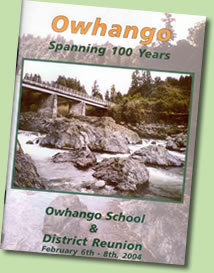Following the previous story about the community group in Pukawa and their pest extermination success to bring back the morning chorus, this is all about another community group based at Owhango. Where is Owhango? In 1908 this was a thriving town with 11 saw mills operating. It is now a tiny friendly village – population about 170 – located on SH4 between National Park and Taumaranui.

It is probably best known by that strange species of fresh water anglers because of the Whakapapa RIver that flows past and joins the W(h?)anganui River at Kakahi and made more famous by classic trout fishing books – “Kakahi” by Peter McIntyre and “The Flies in my Hat by Greg Kelly.

But this blog is not about the legendary trout fishing – instead it is about another wonderful group of community spirited folk whose mission is to protect and enhance the natural environment of the Ohinetonga scenic reserve.

The reserve extends between Owhango and along the banks of the Whakapapa River on both sides of the road down to the river. The bridge across marks the start of the 42nd Traverse – a 4WD and mountain bike trail across the Tongariro Forest Park to SH47 which was milled until 1972. It is now a kiwi sanctuary.

The reserve was formally created in 1921 to protect the unspoilt native bush and mature trees. It now extends 148 hectares with the attractive Ohinetonga 3.8 km loop track formed through the bush with a boardwalk across a lagoon. A full lesurely tourist lap takes about two hours but (ANGLERS NOTE!) the section of track down river to the Boat Pool is now closed due to a large slip. However the remaining tracks and native birds are well worth a visit to view nature at its best.

Naturally TRM cannot blog without showing why so many anglers visit the Whakapapa…



History of Owhango
Prior to the first European arrivals, Owhango was an area well known to Maori travellers. Tribes from Taupo, Wanganui and Taranaki frequently rested, held meetings or replenished their food supplies here.
Surveying the district began about 1880 with the object of finding a route for the proposed railway line. It is believed that Owhango was named by foreign engineers employed in the construction of the Main Trunk Line. Preparation for this construction commenced in the area in 1902 and the first goods train went through in 1906.
1904 was an eventful year – the telephone arrived, a school opened and the Post Office had its first customers (it closed in 1989). Our village hall was erected in 1912.
Owhango was a ‘mill town’ and a number of companies operated in the area in the early days including the Watkins Bros, Asett & Manning and The Matai Sawmilling & Planing Company. The Dominion Timber Company began milling native timbers from around the area in 1933. Businesses and facilities sprang up in Owhango to cater for the needs of the workers and their families who came to live here.
Fortunately a block of the original bush right in Owhango was set aside and was named the Ohinetonga Reserve. It is now a popular walking track for locals and visitors. In 1947 a bridge was built over the Whakapapa River to provide access to the timber in the forest on the other side. These days, in place of forestry gangs, travellers over the bridge include tourists, hunters, trampers and mountain bikers.
The Dominion Timber Company’s last mill burned down in 1977 just before it was due to close. The forest on the edge of Owhango, once called ‘the Dominion’ is now known as Tongariro Forest and is protected as conservation land, thanks to a successful campaign in the 1980s led by the local people to save it from clearance. The Department of Conservation has carried out pest control work in the forest for a number of years with the aim of restoring the habitat for native flora and fauna, including our national bird, the kiwi.
The farmland immediately around Owhango was not available for settlement until 1915-1916, although some adjacent areas had been settled as early as 1908. After the closing of the mills farming became the mainstay of the district. More recently, holidaymakers, tourists and recreationalists are bringing welcome income to the area.
There is an historical swimming pool actually constructed into the bed of the Kakahi Stream, located about 500 metres (1,600 ft) west down Onematua Road from SH4 at the northern boundary of Ōwhango. The pool was created by locals in the hope of preparing one of the local athletes for the “British & Commonwealth Games”. Local records indicate the pool was first ready for use over the 1939/1940 summer. In 1961 a conventional swimming pool in the grounds of the local school was opened.
The Ōwhango Hall was originally used as a silent movies cinema seating 250. In more recent times it has mainly been used for community meetings and events, indoors bowls, and market days.
The Ōwhango Volunteer Fire Brigade has been operating since 1965.
For further information contact OWHANGO ALIVE at owhangoalive@yahoo.com or go to www.owhango.co nz

